Unpopular opinion: we don’t think “done-for-you” works when it comes to ClickUp. And by “works” we mean they often fail to deliver the promises clients want.
We’ve seen it when we’ve provided these services ourselves. We’ve heard the same thing again and again from my fellow service providers who have felt burnt out by the model.
In this video, we’ll go over why “done-for-you” ClickUp services don’t always fulfill the shiny promises they offer.
(NOTE TO SERVICE PROVIDERS: WE’RE NOT OUT TO GET YOU, WE PROMISE! THIS ISN’T ENTIRELY YOUR FAULT!)

Delivering on Quality Services
Last quarter, ProcessDriven turned away about $200,000 dollars worth of client services work. Now, it might seem like this would have been “easy money”, but the fact is, we don’t believe these types of services always live up to their promises of actually being able to be a complete “done-for-you” package.
Done for you services in the ClickUp realm typically cannot fully deliver the promise that they are selling themselves by.
Simply put: “Done-for-you” services don’t work very effectively in the ClickUp space because almost everything you’re going to want to do with ClickUp is going to require more than just the done-for-you element. The service provider will still need your input, your processes, your SOPs, and so much more before they even get started.
In this post, we’re going to go over most of the common selling points that people use for selling “done-for-you” ClickUp services and explain why they just don’t work for most teams.
Here are some of the promises we’re going to cover today:
- The “Improve Efficiency” Promise
- The “Implement Strategies” Promise
- Increasing Team Member Accountability”
- “Manage your Day-to-Day Capacity”
- “Automate your Workflows”
Done for You Service Provider vs. Client. Vs. Strategist
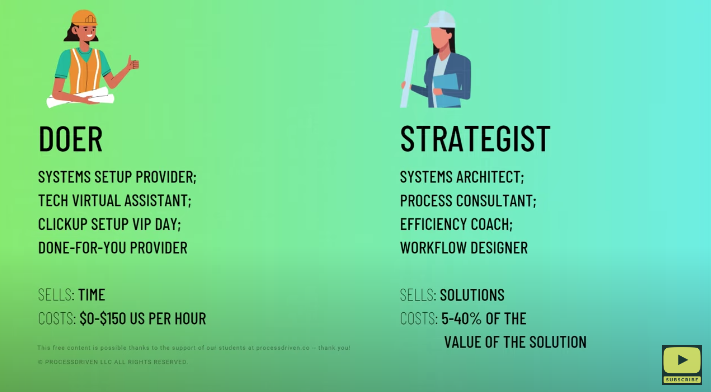
There are two main categories of service providers we’re going to be discussing today: On the left is a doer and on the right is a strategist.
The doer side of things is typically called a “system set up provider”. They’re usually in roles like tech VA, ClickUp setup VIP host, or done-for-you service provider. When working with a “do-er”, you’re primarily buying time back in your day.
On the flip side, we have a strategist. You might see job titles like Systems Architect, Process Consultant, efficiency coach, and workflow designer. From a strategist, you buy solutions.
These are two different people, two different skill sets, even though they both work in ClickUp implementations or ClickUp strategy.
Another way to think about it is a doer is going to take orders and give you what you order. A strategist is going to ask you questions, figure out what you should order, and order it for you.
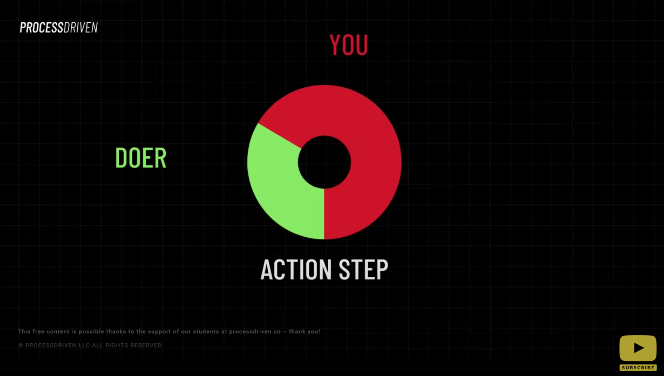
Now, before we move forward, we’re going to use this chart above to clarify what these little colors are going to mean in our examples.
If you’re seeing something that’s red, that is something typically you, the client would have to do. As we go on, you’ll also see blue being introduced, which is the color of the strategist
The important distinction here is that a strategist and a setup provider can be of equal skill.
They’re just working in a different container.
Layla dives into “done-for-you” services providers vs strategists starting at 0:52.
Deconstructing the promise of “Bringing everything together into one place”
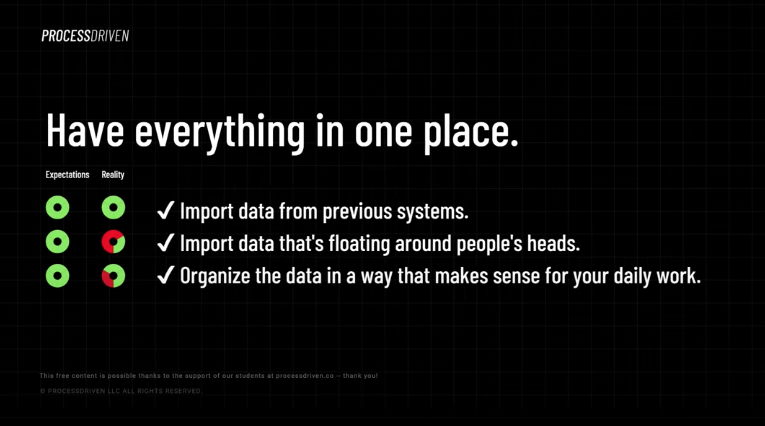
The first marketing promise we want to deconstruct here in the “done-for-you” space is having everything in one place.
You’ll constantly see this on sales pages. In fact, it was probably, at one point, on our own sales page.
“Bring everything together in one place!”
Now, when we go into something like this, the expectation is that they’re going to put everything in one place for ease of your team’s workflow, but the reality isn’t quite so.
As you can see in red, there is a good chunk of the knowledge, documentation, and process work that you as the client are responsible for. Similarly, look at “organize the data in a way that makes sense for your daily work”. You’d think that a setup provider would be able to do that and to a large extent, they can.
However, they still rely on you to understand how your brain works, how your business works, and how your team thinks about doing the work. For that reason, there is really no “done-for-you” option when it comes to setting up ClickUp because at one point or another you’re going to have to do the work to get involved, get it finished and actually, well, work.
As you can see below, the only real exception is the import of data. That is something that just about anybody could do and is something that you can definitely outsource to a “done-for-you” provider.
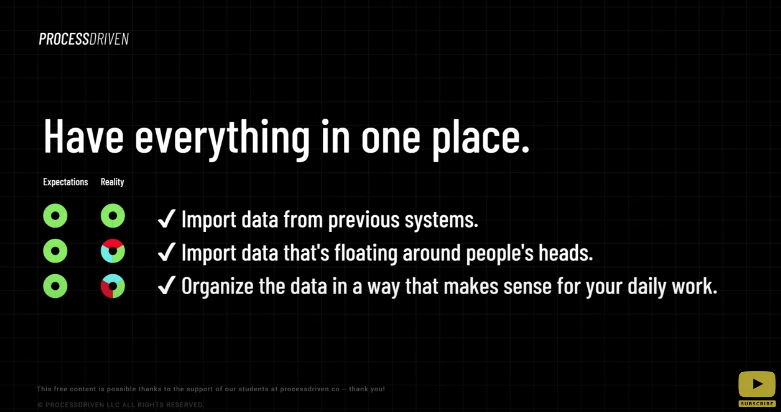
If we incorporate a strategist into this role, which is the blue color that we talked about earlier, you can see how it changes.
We might get help on importing data from people’s heads because that strategist has some good ways for pulling out information, some good exercises for defining processes, etc.
However, we still have to get involved to make sure that data makes sense and flows in a way that is logical to us.
Layla goes over destructing this promise starting at 2:46.
The “Improve Efficiency” Promise

The next promise is the “improve efficiency” promise, which again, we see all over sales pages. They promise to “reduce cost, improve output, get more done!”.
To make this promise a reality, there are three steps:
- Identify what your workflows actually are today
- Measure the efficiency using ClickUp and any other tools you have
- And implement strategies to reduce cost or improve throughput
In an ideal world, we would expect our system service provider to deliver us this promise – it is on their sales page, after all.
In reality, though, efficiency boosts aren’t something that can really happen inside the container of a done-for-you ClickUp model, because improving efficiency is an extremely personal process.
It’s taking into account your own personal habits, your team’s personal habits, your virtual assistant’s habits, how they get work done, etc. And that’s not something that can be done on a VIP day or done in isolation.
Layla expands on this starting at 4:51.
The “Implement Strategies” Promise
Finally, we have implement strategies.
So once we design our workflows, and figure out how exactly we want to change them, absolutely, that system setup provider can take our order and put it into ClickUp.
But have you ever been to a restaurant with a type of food you’ve never had before, you look at the menu, and you have no idea what to order. Maybe it is in a foreign language and you’re looking at it thinking, “what should I order?”.
You just kind of go through the menu until eventually touch something and say, “Sure, this one.” Then your order shows up and you just have to pretend that that looks really good, even though you’re a vegetarian and you just ordered pig’s heart.
That’s the kind of stuff that can happen when you’re just telling someone to implement a strategy that has been created in a silo.
So what’s the alternative? Incorporate that strategic partner to lighten the load, by letting them help you identify your workflows and help you measure the efficiency of your business.
(Wanna know more about how you can measure the efficiency of your business? Check out this video: Measuring Business Success | Tracking Data for Small Business Decision-Making ft. Susan Boles.)
Layla dives into this starting at 6:51
The “Increasing Team Member Accountability” Promise
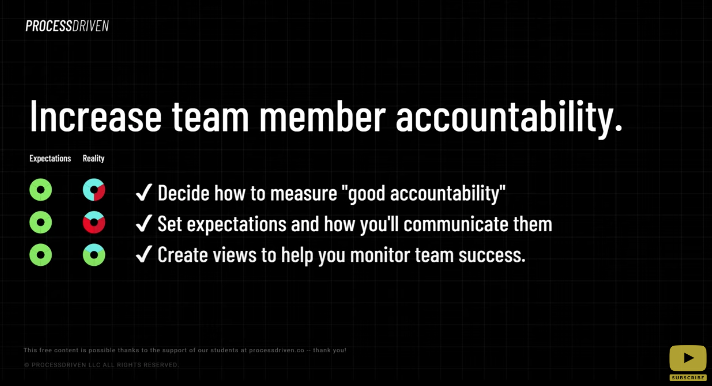
Next up, is the myth of creating team member accountability.
From experience, we can say that it is best for you and your team to decide how you’re going to measure good accountability, set expectations, and communicate them across your team.
(One way to do this is by creating Views and Dashboards in ClickUp to help you monitor your team’s success. Check out How to Add Widgets to ClickUp Dashboards to Keep Your Team on Track (ClickUp Dashboard Example) for some inspiration!)
We’ll just jump right to the punch line here: Done-for-you ClickUp service providers can handle only the implementation part once you decide exactly what your strategy is and communicate with your team accordingly.
So much process work needs to happen in a community, as a movement, as a collective decision that “done-for-you” order taking just tends to not work very well outside the actual hands to keyboard time.
Layla explains why this doesn’t work in “done-for-you” services at 8:05.
The Promise to “Manage your Day-to-Day Capacity“
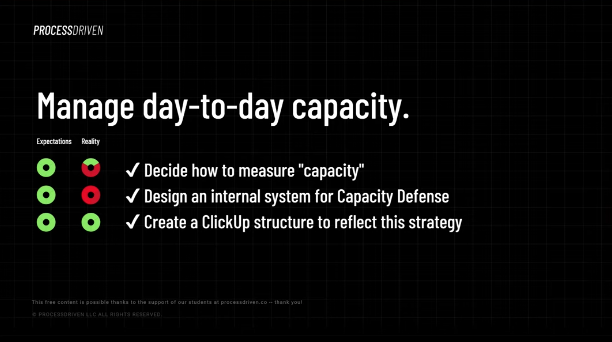
Next up, we have “manage your day-to-day capacity”.
Capacity, in this case, means how much you can handle doing in the given allotted timeframe.
There are steps to truly measuring your team’s capacity:
- Decide how to measure the capacity (whether that be by time estimated, etc.)
- Create a system for defending that capacity (which is something that we teach inside the ProcessDriven Membership)
- And create a ClickUp structure to reflect that strategy
We think that the system setup provider can handle all this stuff, but in reality, they are only in a position to take orders because of the depth of the working relationship.
Layla explains this deeper starting at 8:55
The “Automate your Workflows” Promise
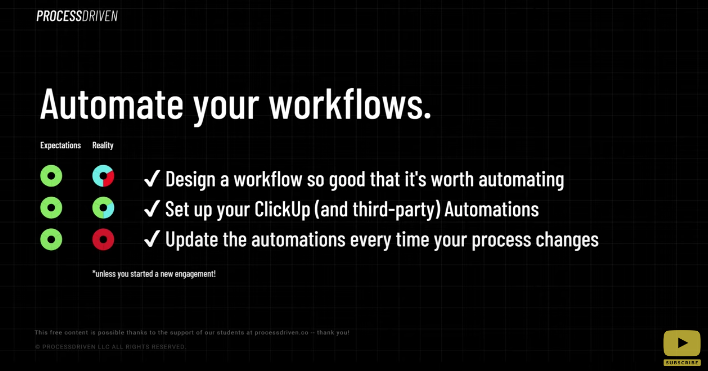
Lastly, “automate your workflows”.
First of all, you need to create a workflow that is so good that you actually should automate it because, you know what they say about automating a terrible process, they just get a lot more terrible, and very quickly.
The point is: don’t automate a process that isn’t in the best shape yet.
(Once you are ready to automate, Check out our guide on how the power of Integromat can help with those automations here.)
Done-for-you ClickUp service providers or strategists can surely take your order and create those automations for you, but when it comes back to the ongoing maintenance, that’s not in their service promise. That’s either a very expensive ongoing contract or you’re going to have to learn the tool.
Eventually, you are still left alone with your automation. You can outsource all these little elements, but at the end of the day, you can’t outsource things like learning the system.
As nice as it is to think that we can just pay money, buy time, and get things taken care of for us: there’s always going to be an element that we need to contribute. (And it’s much bigger than what you’re going to think it is.)
Layla gives you the full overview of why automations are a personal journey starting at 9:43.
To Recap:
Setting up your workflows and your overall project management is one of the most complicated setups you’ll experience in building (and re-building) your business. Your workflow is a living, breathing part of your business that will continue to change. You’ll have to take the time to make sure it’s just right.
The more we can get the expectations of a done-for-you service anchored to reality, the better the job you’re going to be able to do, and the more you can essentially “get out of your own way”. (Which we all struggle with from time to time here, too!)
Thanks so much for taking the time to check out our work here today.
Until next time, enjoy the process.
